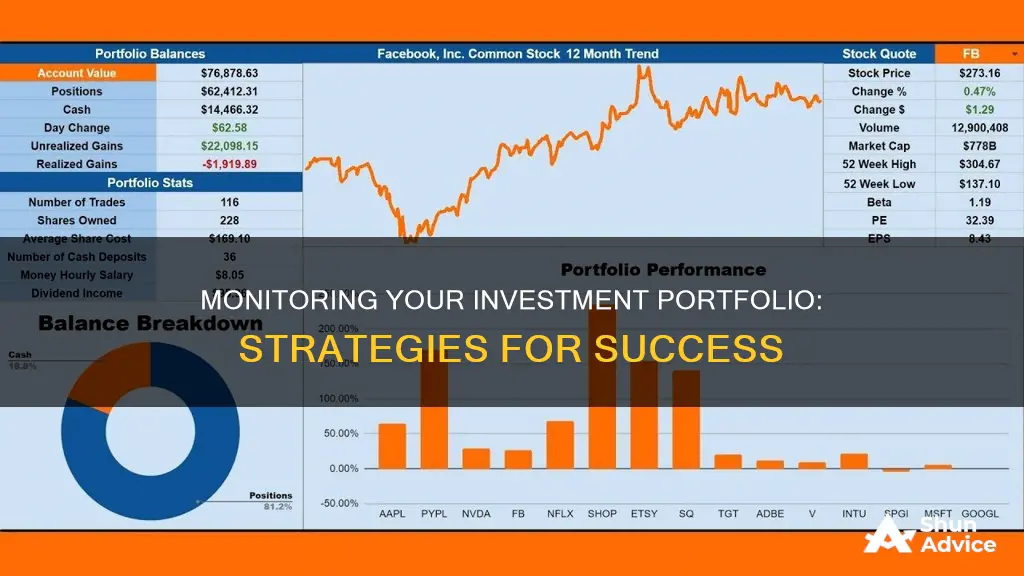
Tracking the performance of your investment portfolio is essential to managing your assets effectively. It involves monitoring and analysing both the returns and risks of your investments over time. While it's important to stay engaged with your holdings, this doesn't mean you need to monitor them incessantly; a yearly evaluation is often enough to keep track of your investment goals. There are various tools and metrics that can help you assess the health of your portfolio, such as mobile investment apps, which offer real-time information on your investments in one place. These apps can help you sync your financial accounts, track asset allocation, and compare your portfolio's performance against a benchmark index or fund. Additionally, you can calculate your total return, which includes capital gains, dividends, and currency fluctuations, to get a comprehensive understanding of your investment performance.
| Characteristics | Values |
|---|---|
| Frequency of evaluation | Yearly |
| Investment types | Stocks, bonds, mutual funds, exchange-traded funds (ETFs), 401(k)s, individual retirement accounts (IRA) |
| Performance measures | Yield, rate of return |
| Tools | FINRA's Fund Analyzer, online annual and total return calculators, mobile investment apps, portfolio management apps, portfolio tracker apps, Sharesight, Yahoo Finance app |
| Metrics | Total return, standard deviation, Beta, R-squared, Sharpe Ratio, Sortino Ratio |
| Calculations | (Change in value + Income) / Investment amount = Percent return |
| Tips | Factor in transaction fees, create a single spreadsheet for all investments, consider the role of taxes on performance, factor in inflation, compare returns over several years, rebalance as needed |
| Features | Free version of the app, easy-to-use financial syncing of all investment and banking accounts, dashboard with reporting functions, retirement planner tool, access to charts, dividend tracker, fee monitor |
What You'll Learn

Calculate total return
Calculating the total return of your investment portfolio is a key metric for performance evaluation. It involves measuring the overall returns of an investment and comparing returns across asset classes. This is generally considered the most accurate measure of return.
To calculate the total return, you need to add the change in value (up or down) from the time of purchase to all the income collected from that investment in interest or dividends. This is known as the rate of return. You can then divide the change in value plus income by the amount invested to find the percentage return.
For example, if you invested $2,000 to buy 100 shares of a stock at $20 per share, and over three years, the price increased to $25 per share with a total of $120 in dividends, you would add the $500 increase in value to the $120 in dividends. To find the percentage return, you would divide by $2,000, resulting in a 31% return.
However, this number alone doesn't give the full picture. To make an accurate comparison of the performance of your investments, you should calculate the annualised return. This can be done using the following formula:
AR = (1 + return) x (1 / years) - 1
In the above example, the annualised return would be 9.42%.
It is also important to consider other factors that may impact your total return, such as transaction fees, taxes, and inflation. Additionally, you may want to compare your returns over several years to identify patterns in the performance of your investments.
Strategies for Landing Investment Portfolio Leads
You may want to see also

Choose a monitoring time horizon
When choosing a monitoring time horizon, it's important to consider your investment goals and strategies. The time horizon is the period you expect to hold an investment before needing to access the funds. This can range from a few years to several decades and is influenced by factors such as your age, income, and lifestyle.
Here's a breakdown of the different types of time horizons:
Short-Term Investment Horizon
The short-term horizon refers to investments that are expected to last for fewer than five years. This type of horizon is suitable for individuals approaching retirement or those who may need a large sum of cash in the near future. Investment vehicles such as money market funds, savings accounts, certificates of deposit, and short-term bonds are commonly chosen for short-term goals as they can easily be converted into cash.
Medium-Term Investment Horizon
Medium-term investments are those held for three to ten years. People saving for significant life events like buying a home, marriage, or a child's education typically fall into this category. A mix of stocks and bonds is a popular strategy for medium-term horizons, balancing the potential for growth while preserving wealth.
Long-Term Investment Horizon
The long-term investment horizon is for goals that are more than ten years away, with retirement savings being the most common example. Long-term investors are generally willing to take on more risk in exchange for higher potential returns. They can ride out short-term market fluctuations and benefit from the power of compounding over time.
It's worth noting that your time horizon can change over the course of your life as your goals and circumstances evolve. For instance, you might start with a long-term horizon when you're young and adjust it to a medium or short-term horizon as you get closer to your financial goals.
Additionally, your risk tolerance and investment strategies will also play a role in determining your time horizon. Aggressive investment strategies with a higher risk appetite are typically associated with longer time horizons, while more conservative approaches are often chosen for shorter time horizons.
Savings and Investments: Economy's Growth Engine
You may want to see also

Select a performance benchmark
When selecting a performance benchmark, investors may use one or multiple benchmarks depending on the investments held in their portfolio. For example, the primary benchmark used for stocks is the S&P 500 index, and the main performance benchmark for bonds is the Barclays US Aggregate Bond Index.
Investors may also use multiple benchmarks for monitoring portfolio performance or for measuring individual investment security performance.
It is important to select appropriate benchmarks, such as the S&P 500 index for a stock portfolio or the Barclays Aggregate Bond Index for a fixed-income portfolio.
Additionally, investors can use statistical measures such as Standard Deviation, Sharpe Ratio, and R-squared to measure the risk of a portfolio. Standard deviation measures the volatility of an investment or portfolio, with a higher standard deviation indicating greater price variation. Beta is another statistical measure that assesses an investment's risk compared to a market benchmark. The Sharpe ratio measures risk-adjusted returns, helping investors decide if the additional risk of an asset or portfolio justifies its return. Meanwhile, the R-squared is a statistical measure that represents an investment's price movements that correlate with the movements of its benchmark index.
Savings or Investing: Which Offers Better Liquidity?
You may want to see also

Monitor performance and risk metrics
Monitoring the performance and risk metrics of your investment portfolio is crucial for effective financial management. Here are some detailed instructions and considerations to help you track and evaluate your portfolio's performance:
- Choose a Suitable Time Horizon: Selecting an appropriate time horizon for monitoring your investments is essential. Consider your investment goals and style. For instance, if you are investing for retirement, you may want to focus on 5-year and 10-year returns rather than shorter periods. The most common monitoring period is one year, and for longer periods, returns are typically "annualised". The most commonly published rates of return are 1-year, 3-year, 5-year, and 10-year returns.
- Select Performance Benchmarks: Choose relevant benchmarks for your portfolio based on the types of investments it holds. For example, the primary benchmark for stocks is the S&P 500 index, while the Barclays US Aggregate Bond index is the main benchmark for bonds. You can use one or multiple benchmarks to measure your portfolio's performance.
- Calculate Total Return: Measuring the total return of your investments is a critical aspect of performance monitoring. This includes considering factors such as capital gains, dividends, and currency fluctuations. Compare your portfolio's total return against your chosen benchmark(s) to assess how your investments are performing relative to the market.
- Monitor Risk Metrics: In addition to return, it is essential to assess the risk associated with your investments. Some common risk metrics include Standard Deviation, Beta, R-Squared, Sharpe Ratio, and Sortino Ratio. These statistical measures help evaluate the volatility and risk-adjusted returns of your portfolio.
- Frequency of Monitoring: Decide on a suitable frequency for monitoring your portfolio's performance and risk metrics. A common choice is quarterly monitoring, as investment data is often reported on a quarterly basis. Regular monitoring helps you stay informed and make adjustments if needed.
- Utilise Portfolio Management Apps: Take advantage of portfolio management apps that offer real-time information and analytics. These apps can sync with your financial accounts and provide valuable insights into your investments' performance. Examples include Empower, SigFig Wealth Management, Sharesight, and Yahoo Finance.
- Consider an Investment Policy Statement (IPS): Creating an IPS can help outline your investment strategy, goals, objectives, and performance metrics. This document can guide your investment decisions and ensure you stay on track.
- Factor in Other Elements: When evaluating performance, consider transaction fees, taxes, inflation, and the impact of different time periods. These factors can influence your overall returns and should be included in your calculations for a more accurate assessment.
By following these steps and staying vigilant, you can effectively monitor the performance and risk metrics of your investment portfolio, enabling you to make informed decisions and work towards achieving your financial goals.
Savings: Invest Today, Secure Your Future
You may want to see also

Compare performance over multiple periods
Comparing the performance of your investment portfolio over multiple periods is essential for understanding how your investments have fared in different market environments and over time. Here are some ways to do this:
Annualised Returns
Annualised returns allow you to compare multi-period returns across different investments or portfolios. It provides a standardised yearly figure that accounts for the effect of compounding. This method is useful for comparing investments across the board, regardless of their original timelines. However, it does not indicate the volatility experienced during the period in question.
Time-Weighted Returns (TWR)
TWR focuses on the portfolio's investment performance by removing the impact of external cash flows such as deposits and withdrawals. This provides a more accurate measure of the effectiveness of your investment strategy or your investment manager. TWR is calculated by finding the rate of return for each sub-period, adding 1 to it, multiplying these figures together, and then subtracting 1 from the total.
Money-Weighted Returns (MWR)
MWR, on the other hand, accounts for the timing and size of an investor's contributions and withdrawals. It reflects the personal return experienced by the investor, capturing the impact of their individual choices on investment outcomes. However, MWR is not well-suited for comparing the performance of different fund managers or investment strategies because it doesn't isolate the returns on investments from investor decisions.
Holding Period Return (HPR)
HPR is a metric that includes income from sources like dividends or interest payments in addition to capital gains or losses. It is useful for comparing investments with different holding periods, providing a normalised view of returns. HPR is calculated using the formula: HPR = Income + (End of Period Value — Initial Value) ÷ Initial Value.
Modified Dietz Method
This method adjusts for the timing and size of cash flows, providing a more precise gauge of portfolio performance. It weights each cash flow by the time it has been in or out of the portfolio.
Sharesight's Multi-Period Report
Sharesight is a portfolio management software that offers a Multi-Period Report. This report allows investors to compare their portfolio returns over up to five distinct or cumulative periods. It is an effective way to evaluate the impact of a portfolio rebalance, assess performance before and after a market correction, or compare returns against fund manager performance periods.
Creating Your First Investment Portfolio: A Beginner's Guide
You may want to see also
Frequently asked questions
It is recommended to evaluate your investments at least once a year at roughly the same time each year. This keeps you engaged in your holdings and helps you track the progress of your investment goals.
There are several ways to measure the performance of your investment portfolio, including:
- Yield: A yield is typically expressed as a percentage and is a measure of the income generated by an investment over a specific period, usually a year.
- Rate of Return: This is the total money you make or lose on an investment. It is considered the most accurate measure of return.
- True-Time Weighted Return: This is a calculation of the overall performance of an investment portfolio across all accounts.
There are several tools available to track the performance of your investment portfolio. Many firms provide online access to your account information. You can also use portfolio management apps such as Empower, SigFig Wealth Management, Sharesight, and Yahoo Finance. These apps can provide information on your investments from 401ks to IRAs and offer retirement tracking and planning.







